Elon Musk: ‘Mandatory, Institutionalized Racism And Sexism!’
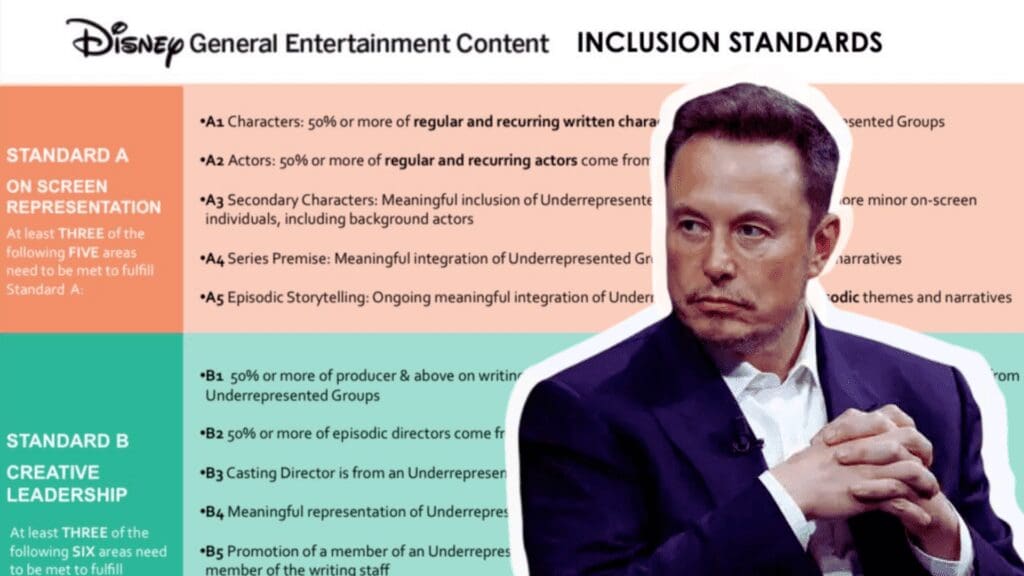
X owner Elon Musk on Feb. 6 revealed a Disney document entitled, “Disney General Entertainment Content Inclusion Standards,” that outlines the corporation’s hiring and creative diversity, equity and inclusion (DEI) policies as he prepares a class action lawsuit against the company for racial and gender employment discrimination, which fired Mandalorian actress Gina Carano will be participating in.
The document reveals apparent racial and gender hiring quotas in what would be a clear violation of Title VII of the Civil Rights Act that prohibits employment discrimination on the basis of race, sex and religion.
In publishing the document to his X account, Musk wrote, “An anonymous source just sent me this from Disney. It is mandatory, institutionalized racism and sexism!”
As it turns out, Musk did not need an anonymous source to expose the policies, as the documents are published publicly on Disney’s website for Disney General Entertainment in its pitches to investors.
RELATED: Disney+ Drops Another 1.3 Million Subs in 2024, Continues Trend Of Lost Subs And Bad Content

An identical guide for ABC Entertainment, a subsidiary of Disney General Entertainment was also published.
According to the company’s website, in publishing the one-pagers, Disney promised to “reimagin[e] the way we tell stories and who tells them”: “We are committed to inspiring a more inclusive world by reimagining the way we tell stories and who tells them. Our intention is to broaden access and diversity in our industry by adopting inclusion standards across Disney General Entertainment* and live-action Studio productions by the end of 2022, with the goal of advancing representation in front of and behind the camera, in marketing and more. Linked here is an example of the Inclusion Standards launched at ABC Entertainment in September 2020.”
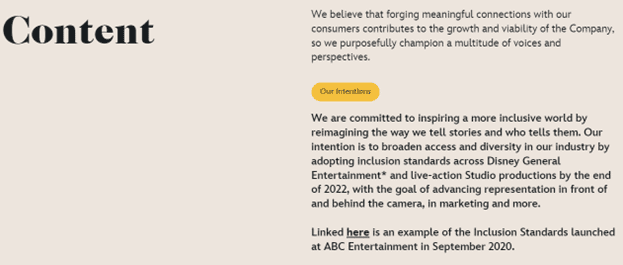
According to the document, Disney uses four standards, A) “On-Screen Representation”; B) “Creative Leadership”; C) “Below-The-Line”; and D) “Industry Access & Career Development”.
Under Standard A, “On-Screen Representation”, three out of these five standards must be used to meet the standard: “Characters: 50% or more of regular and recurring written characters come from Underrepresented Groups… Actors: 50% or more of regular and recurring actors come from Underrepresented Groups… Secondary Characters: Meaningful inclusion of Underrepresented Groups as secondary or more minor on-screen individuals, including background actors… Series Premise: Meaningful integration of Underrepresented Groups in overall themes and narratives… Episodic Storytelling: Meaningful integration of Underrepresented Groups in episodic themes and narratives…”
Under Standard B, “Creative Leadership”, three out of these six standards must be used to meet the standard: “50% or more of producer & above on writing staff and 50% or more of Co-Producer & below on writing staff come from Underrepresented Groups… 50% or more of episodic directors come from Underrepresented Groups… Casting Director is from an Underrepresented Group or has not previously worked on a DGE [Disney General Entertainment] show in this role… Meaningful representation of Underrepresented Groups in senior creative leadership… Promotion of a member of an Underrepresented Group into a role that constitutes career progression for at least one member of the writing staff… Substantial year-over-year increase in members of Underrepresented Groups as directors and in writing staff…”
For Standard C, “Below-The-Line”, two out of these five standards must be used to meet the standard: “50% or more of line producer and/or production department heads (ie: DP, composer, costume designer, editor, production designer, music supervisor…) come from Underrepresented Groups… 50% or more of other key roles (any mid-level crew and technical positions) come from Underrepresented Groups… 50% or more of the overall crew or project staff come from Underrepresented Groups… Promotion of member of Underrepresented Groups into a role that constitutes career progression for at least one crew/team member… Hiring a Line Producer and/or Production Department Head who has not been previously employed in that role on a DGE Show…”

And under Standard D, “Industry Access & Career Development”, three out of six of these standards must be used to meet the standard: “Paid employment opportunities such as apprenticeships, interships, expert advisers to facilitate union eligibility for members of Underrepresented Groups (CTDI PA Program qualifies)… Training opportunities and/or skills development (craft, creative and business), including one-off, work-experience opportunities for students from underrepresented groups (to be coordinated through Current Executive & Corporate Social Responsibility)… ‘First job’ for member of Underrepresented Group in a role that constitutes career progression from prior training (Staffing from CTDI Writing or Directing Program qualifies)… 50% or more of outside vendors or contractors employed by production provide industry access or opportunities to members of Underrepresented Groups as defined in D1-D3… Producer or Department head participation in DGE Talent Development initiative, guild or other approved mentorship program (Participating as a Panelist/Presenter at a CTDI event qualifies, Mentorship will be vetted by Current Executive)… Producer develops/executes a show-specific D&I subject to Network approval…”
Musk is right. These appear to be racial and gender hiring quotas, which are an explicit violation of Title VII of the 1964 Civil Rights Act’s prohibition on employment discrimination on the basis of race or sex: “It shall be an unlawful employment practice for an employer… to fail or refuse to hire or to discharge any individual, or otherwise to discriminate against any individual with respect to his compensation, terms, conditions, or privileges of employment, because of such individual’s race, color, religion, sex, or national origin; or … to limit, segregate, or classify his employees or applicants for employment in any way which would deprive or tend to deprive any individual of employment opportunities or otherwise adversely affect his status as an employee, because of such individual’s race, color, religion, sex, or national origin.”

That’s the law of the land, still on the books, however, in the 1979 Steelworkers v. Weber Supreme Court decision, the court ruled that employment policies that include racial preferences on the basis of race and sex in favor of women and minorities, which plaintiffs argued was reverse discrimination, were not a violation of the Civil Rights Act. This had the unfortunate effect of legalizing employment discrimination against whites and males, a sharp departure from more racially neutral interpretations of the Civil Rights Act by federal courts that preceded the decision.
Then Associate Justice William Rehnquist (who became Chief Justice in 1986), in his dissent, compared the ruling to the totalitarian regime portrayed in George Orwell’s 1984 by changing the law’s true meaning: “Taken in its normal meaning, and as understood by all Members of Congress who spoke to the issue during the legislative debates, this language prohibits a covered employer from considering race when making an employment decision, whether the race be black or white.”

Rehnquist added, “the Court behaves much like the Orwellian speaker earlier described, as if it had been handed a note indicating that Title VII would lead to a result unacceptable to the Court if interpreted here as it was in our prior decisions. … Now we are told that the legislative history of Title VII shows that employers are free to discriminate on the basis of race: an employer may, in the Court’s words, ‘trammel the interests of the white employees’ in favor of black employees in order to eliminate ‘racial imbalance.’… Our earlier interpretations of Title VII, like the banners and posters decorating the square in Oceania, were all wrong.”
45 years later, the impacts of the ruling in favor of affirmative action, now dubbed DEI, can be seen, even as employers attempt to feign compliance with the Civil Rights Act.
The Disney one-pager also vaguely advises that “Context is critical when evaluating if a group is ‘underrepresented.’” But then more explicitly states, in an apparent attempt — cover your ass (CYA) — to comply with Title VII of the Civil Rights Act that those hiring candidates cannot explicitly ask about the prospect’s race, sex, sexual orientation, etc. when interviewing for the job: “Anyone involved in hiring decisions is prohibited from asking candidates and talent about their actual or perceived race, religion, color, sexual orientation, gender, gender identity, military or veteran status, age, disability, or any other legally protected categories.” That, even though human resources personnel are supposed to be using the guides to hit the quotas.
But they’re not quotas, Disney assures itself in an “Inclusion Standards: Frequently Asked Questions” (FAQ) that Musk also posted to X on Feb. 6, which asks, “Do the Inclusion Standards require or encourage productions to reserve a certain number open positions for underrepresented groups?”
Right off the bat, if these are not racial and gender hiring quotas, then why is asking if these are quotas a “frequently asked question” in its CYA FAQ? Here Disney is admitting outright that it “frequently” must defend its racial and gender hiring quotas as not being quotas — because they are. You can’t make this stuff up. As Rehnquist would have noted, this is Orwellian Newspeak propaganda.
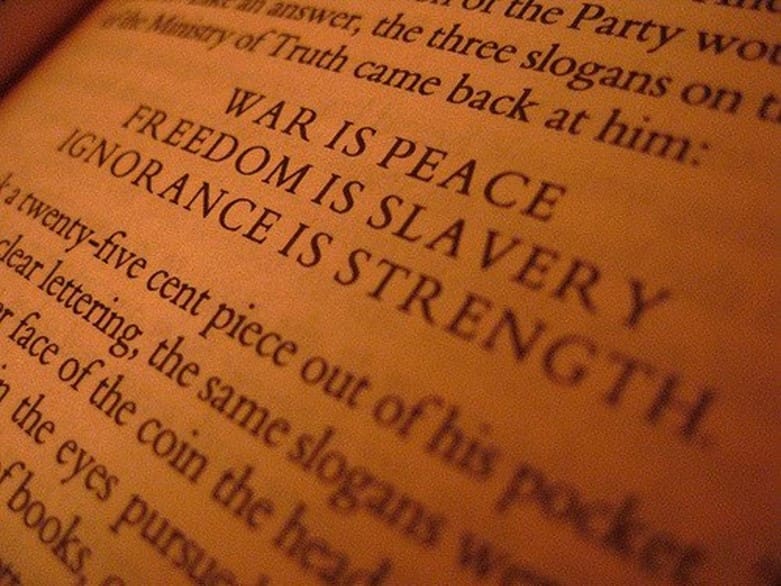
The FAQ responds that this is simply about “reinforcing inclusive practices”: “No. The Inclusion Standards are about reinforcing inclusive practices. This means that productions will meet the inclusion standards by engaging in the inclusive hiring and employment practices described above.”
And they are definitely not quotas, even though Disney is apparently “frequently” asked if they are: “The Inclusion Standards do not require, encourage, or permit the use of quota systems or the making of employment decisions based on someone’s race, gender, or other demographic identities.”
Despite the bar on quotas-based hiring, Disney managed to conduct a comprehensive survey of its company both worldwide and in the U.S., “Workforce Diversity Dashboard” for Fiscal Year (FY) 2022, breaking down employees on the basis of race, ethnicity, and sex, with the most important quotas that are not quotas including women and people of color.
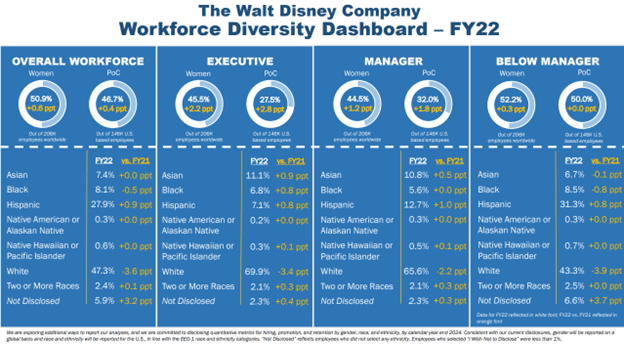
The “Workforce Diversity Dashboard” dutifully reported that worldwide, women had increased 0.6 percentage points to 50.9 percent in FY 2022, and in the U.S., people of color had increased 0.4 percentage points to 46.7 percent of the U.S. workforce.
Across every category in the U.S., whites were reduced as a percentage of the workforce, down 3.6 percentage points to 47.3 percent of the workforce overall, down 3.4 percentage points to 69.9 percent of executives, down 2.2 percentage points to 65.6 percent of managers and down 3.9 percentage points to 43.3 percent for below managers.
These are fairly explicit racial and gender hiring quotas but are not at all uncommon for publicly traded companies that tout their Environmental, Social, and Governance (ESG) metrics to investors, including hitting DEI goals, with entertainment companies Warner-Discovery, Hasbro, and Mattel all touting similar goals.

But it is not limited to just entertainment, it impacts industries across the board, for example, pharmaceuticals like Pfizer.
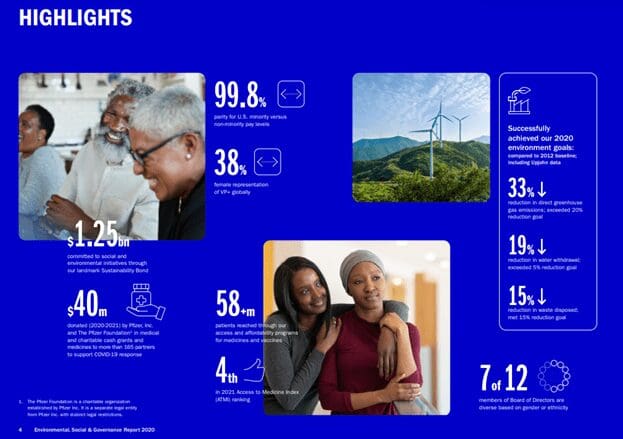
Disney Publishing Worldwide, a subsidiary of Disney Experiences, which publishes Marvel Comics, uses similar DEI standards for the company’s parks, cruises, and publishing lines, reminding investors that “Representation Matters”.
For example, in 2021, Marvel published Marvel Voices: Comunidades, highlighting the role of editor Angélique Roché, who told Marvel.com in a promotion of the book: “I hold a couple of roles at Marvel; I’m a host and producer for the Marvel’s Voices and Women of Marvel podcasts. I curate and edit the Marvel’s Voices spotlight series for Marvel.com and serve as a consulting editor for MARVEL’S VOICES comics. I also serve as a Diversity and Inclusion consultant for Marvel. Overall, I serve as a member of the editorial team [on COMUNIDADES]. Working closely with Lauren and Sarah, I help develop and curate ‘additional’ content unique to each MARVEL’S VOICES anthology, like identifying key voices for interviews and putting together each book’s unique introduction.”
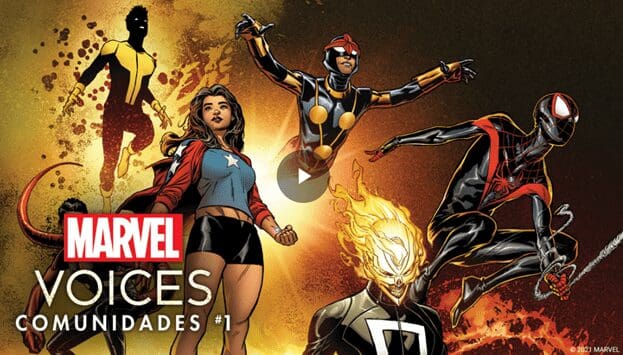
Now, Musk is pursuing aggressive litigation against Disney for its allegedly illegal hiring practices, stating on X on Feb. 6 as he exposed Disney’s Inclusion Standards, “If you were discriminated against by Disney or its subsidiaries (ABC, ESPN, Marvel, etc), just reply to this post to receive legal support…” and “Please let us know if you would like to join the lawsuit against Disney…”
For a company as large as Disney — 225,000 employed — to hit their DEI metrics on an annual basis must be negatively impacting hundreds if not thousands of employees since to make room for diversity hires, others must be let go. Even failure to allow, say, white, male employees to participate for promotion in a diversity program could constitute a Title VII violation, as was alleged in the Steelworkers case.
In the end, companies like Disney will have to answer for their racial and gender hiring quotas they insist like the statists in Orwell’s 1984 are not quotas, likely in federal court, for what appears to be decades of discrimination that now has poisoned America’s culture and body politic. No more. As Musk is fond of stating, they f***ed around, and now they’re about to find out.
Robert Romano is a contributor to the Fandom Pulse and the Editor-in-Chief of Comicsgate.org.
NEXT: Disney Invests $1.5 Billion In Fortnite And Gears Of War Developers Epic Games

Leave a Reply